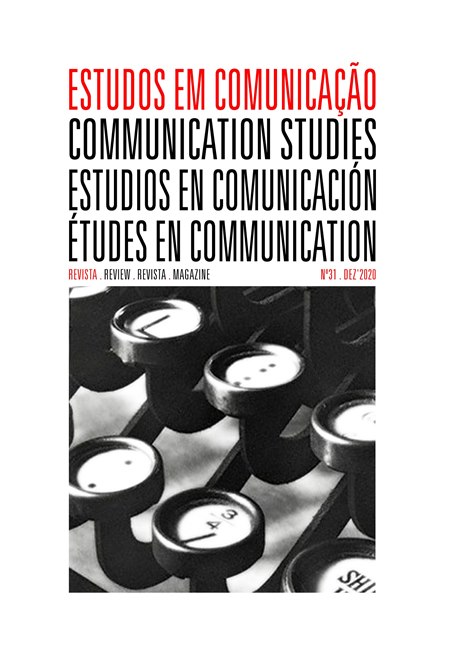“O quixotesco Boris Johnson” da pandemia de Covid-19
Keywords:
narrative, journalism, media character, politics, pandemic, Covid-19Abstract
British Prime Minister Boris Johnson began to be the target of criticism in the country’s own media even before the coronavirus pandemic was declared, which took place on 11 March by the World Health Organization.
Also, in March, the government spokesman tested positive for Covid-19 and was in a critical state of health in a process of hospitalization. To put the case in perspective in Portugal and intending to understand how the journalistic narrative built the media character in question, we will analyse the news article "Specials, but few"in the Portuguese weekly newspaper Expresso, published on May 23, 2020. The methodological approach combines narratology and journalism theory, considering news narrative as a fundamental element for knowledge of the world and a field of formation and representation of identities. From these perspectives, we tend to understand how the media character Boris Johnson was built in the context of a pandemic crisis. The British Prime Minister figured from the characteristics of the protagonist of Miguel Cervantes’ literary work. It was possible to analyse how the character Don Quixote moves from the fictional-literary plane to the factual-journalistic plane and how his survival served to characterize him as crazy.
References
Araújo, B. (2017). Estudos narrativos e teoria do jornalismo: a narrativa de Veja e IstoÉ sobre uma manifestação de estudantes da USP. Coimbra: Imprensa da Universidade de Coimbra. http://hdl. handle. net/10316.2/41340.
Barthes, R. (1981). Análise estrutural da narrativa. (7 ed) Petrópolis: Editora Vozes.
Celedón, E. (2008). Unamuno: Vida de Dulcinea do Toboso. Atas do XI Congresso Internacional da ABRALIC Tessituras, Interações, Convergências. São Paulo, Brasil: USP.
Costa Vieira, M. (2005). Louco lúcido: Dom Quixote e o Cavaleiro do Verde Gabão. Revista USP, (67): 282-293.
Cro, S. (1973). Cervantes entre don Quijote y Dulcinea. Hispanófila, (47): 47-57.
Fulton, H. (2005). Print news as narrative. In H. Fulton, R. Huisman, J. Murphet & A. Dunn, Narrative and media (pp. 218-244). Cambridge: Cambridge University Press.
Luhmann, N. (2006). A Improbabilidade da Comunicação. (Seleção e Apresentação João Pissarra) 4º edição. Lisboa: Vega.
Marques, I. (2020). Personagens no jornalismo: a cobertura da morte de Mário Soares no Diário de Notícias e no Observador. In C. Reis (org.), Dinâmicas da Personagem: Colóquio Internacional"Figuras da Ficção 5" (pp. 171-191). Coimbra: Imprensa da Universidade de Coimbra.
Mesquita, M. (2003). O quarto Equívoco – o poder dos media na sociedade contemporânea. Coimbra: Minerva Coimbra.
Motta, L. (2017). Análise pragmática da narrativa: teoria da narrativa como teoria da ação comunicativa. In A. Peixinho & B. Araújo, Narrativa e Media: géneros, figuras e contextos (pp. 43-69). Coimbra: Imprensa da Universidade de Coimbra.
Peixinho, A.& Araújo, B. (2017). A narrativa da desconfiança na política: a figuração do político. In A. Peixinho & B. Araújo, Narrativa e Media: géneros, figuras e contextos (pp. 233-267). Coimbra: Imprensa da Universidade de Coimbra.
Reis, C. (2014). Pessoas de livro: figuração e sobrevida da personagem. Revista de Estudos Literários, 4: 43-68.
Reis, C. (2018). Figura, pessoa, figuração. Colóquio Letras, (199): 9-19.
Ryan, M. (2009). Narration in various media. In P. Huhn, et al. (eds.), The Living handbook of narratology, 1, (pp. 468-488).
Tenório, K. (2019). Dom Quixote e João Grilo: uma análise das personagens principais d’O Auto da Compadecida e de Dom Quixote de La Mancha, suas aventuras e desventuras. Revista Cadernos Cênicos, 1(1): 1-14.
Tomkins, L. (2020). Where is Boris Johnson? When and why it matters that leaders show up in a crisis. Leadership, 1742715020919657.
Traquina, N. (2002). O que é Jornalismo. Lisboa: Quimera Editores.
Tuchman, G. (2002). As notícias como uma realidade construída. In J. Esteves, Comunicação e Sociedade (pp. 94-104). Lisboa: Livros Horizonte.
Tuchman, G. (2013). The production of news. In K. Jensen (ed.), A handbook of media and communication research (pp. 90-102). London and New York: Routledge.
van Dijk, T. (2017). Discurso, notícia e ideologia: estudos na análise crítica do discurso. Famalicão: Edições Húmus.
Downloads
Published
Issue
Section
License
Estudos em Comunicação/Communication Studies is an Open Access journal. All its content is freely available without charge to the user or his institution. Users are allowed to read, download, copy, distribute, print, search, or link to the full texts of the articles in this journal without asking prior permission from the publisher or the author. Estudos em Comunicação, by Labcom, is licensed under a Creative Commons Atribuição-NãoComercial-SemDerivações 3.0 Unported License. By submitting your work to Estudos em Comunicação/Communication studies you confirm you are the author and own the copyright, that the content is original and previously unpublished, and that you agree to the licensing terms.


